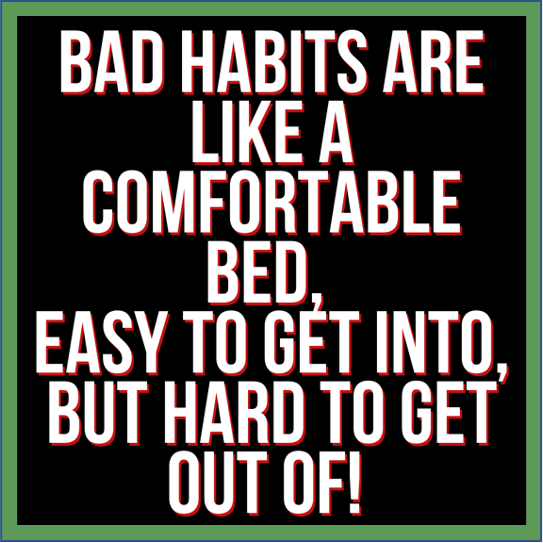Bad Habits and How to Break Them
Everyone has habits, some are good and some are ones we wish we could break. Habits all start with a psychological pattern. First there is a trigger, then a routine, all leading up to a reward that your brain likes that helps you remember the habit loop. Breaking (or changing) habits is not easy, but it’s also not impossible. It all starts with desire to make the change.
Steps to get started and make a change
Figure out what your bad habits are that you are ready to break.
Get to the bottom of why these habits exist. Trying to understand if there is a reason for these habits can help break them. If we are doing something out of emotions or boredom or just mindlessness, being aware of these triggers is the first step to being able to change them.
Start slow. Make one change at a time, do something manageable so it lasts.
Goals need to be specific and realistic
Take small steps, obtaining small goals can help keep you motivated to continue. These are habits that we want to change for a lifetime not just for the short term, small steps make a big change.
How to Break Mealtime Habits:
Schedule: Have a schedule for meals and snacks, this helps avoid mindless eating and ravenous snacking. If you tend to be someone who skips meals or gets so busy that you forget lunch and then all of a sudden are so hungry that you will eat anything in site, having a schedule can help control this ravenous hunger. Even if you aren’t starving at your scheduled lunch time, encouraging yourself to have a snack even something small can help keep your blood sugar levels in check so you don’t go crazy later on.
Plan: Planning your meals for the week and doing some meal prep over the weekends can take the stress and worry out of making the decision everyday. Spending a little time to get organized over the weekend may sound daunting but it will be a huge time and stress savor during the week. Often, by the end of the day we are too tired, overworked, or overstressed to want to spend time cooking or even deciding what to eat. This leads us to choosing the simplest, which often is not the healthiest, options. However, if you already have the meal planned and even the stressful prep work done, you are taking the hardest part out of your meals and ensuring you are in control of your meals.
Prepare: Be prepared before traveling or going out to eat. When traveling try to bring snacks with you. Protein bars, mixed nuts, fruit or PB&J sandwiches are great options. Bringing your own meals or snacks will help you avoid the issue of not finding healthy options or not having the time to grab food. Before eating out, look up restaurant menus to find the most nutritious option. It’s very easy to get influenced by the sites and smells (and hunger) when walking in restaurant. Know what you are going to get before you get distracted by your senses.
Snacks: Bring your own snacks to work or have healthy snacks easily accessible at your workstation. Packs of mixed nuts, protein bars, or single serving of popcorn are easy options to keep around. Bring fresh fruit, yogurt or hummus and veggies as an easy fresh option to have around.
In Home: Set your kitchen and home up for success. Display fruit on the counter or in the front of the fridge for more mindful eating. We tend to eat with our eyes first so let fruit be the first thing we see when looking for something to eat. Put snack foods and more indulgent treats on higher shelves, this may not stop us from eating them but it will allow it to be a more mindful decision.
Be mindful. Slow down and pay attention to what you’re eating. Savor your food and enjoy your company. Get rid of distractions, turn off the TV and put your phone down. There have been many studies that show how we tend to eat more when distracted. We aren’t paying attention to our hunger and full cues and therefore tend to overeat.

